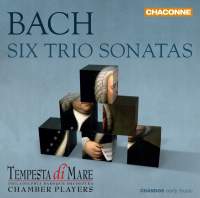Texte paru dans: / Appeared in:

Fanfare Magazine: 38:2 (11-12/2014)
Pour
s'abonner / Subscription information
Les abonnés à Fanfare Magazine ont accès aux archives du
magazine sur internet.
Subscribers to Fanfare Magazine have access to the archives of the magazine
on the net.
Chandos
CHAN0803

Code-barres / Barcode : 0095115080320
Back in
34:4 and then again in 36:4, I reviewed recordings of Bach’s trio sonatas
for organ in other instrumental arrangements: the first time for a Baroque
string trio and harpsichord (the Brook Street Band), the second time for
varied ensembles of two to five instruments (Florilegium). This latest
release by Philadelphia’s resident Baroque orchestra, Tempesta di Mare, is
directly competitive with the latter, utilizing anywhere from two to six
performers in a given sonata. As I have discussed the issues involved in
such arrangements in those prior reviews, I will forego repetition of that
this time.
How do the performances compare? Both sets of arrangements are effective,
and both ensembles play superbly; you can’t go wrong with either one, and
should delight in having both. However, there is a clear difference in
interpretive approach, in a case where timings do tell the story. With only
one exception (the opening Allegro of BWV 529), Florilegium takes a faster
tempo than Tempesta in every fast movement, and a slower tempo in every slow
movement. Thus, Florilegium lays a stress on contrasts, whereas Tempesta
emphasizes continuity. While Florilegium’s interpretive profile happens to
appeal more to my personal taste, that is a purely subjective judgment;
certainly, I would not want to forego the exceptionally fine recorder
playing of Gwyn Roberts and the nimble finger-work of Adam Pearl at the
harpsichord for Tempesta (especially since illness prevented me from
attending the concert from which these recordings derived). As always,
Chandos lavishes on Tempesta its trademark rich recorded sound; exemplary
and detailed booklet notes, artist bios, and table of contents; and multiple
photos. In sum, Tempesta and Chandos have added another winning entry to
their ongoing series; long may it thrive! Heartily recommended.
Fermer la fenêtre/Close window
Cliquez l'un ou l'autre
bouton pour découvrir bien d'autres critiques de CD
Click either button for many other reviews


